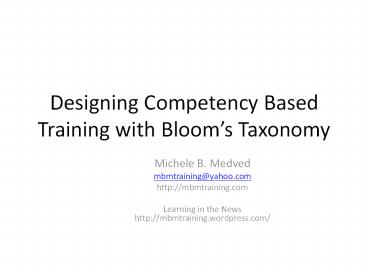Designing Competency Based Training with Bloom - PowerPoint PPT Presentation
Title:
Designing Competency Based Training with Bloom
Description:
Designing Competency Based Training with Bloom s Taxonomy Michele B. Medved mbmtraining_at_yahoo.com http://mbmtraining.com Learning in the News http://mbmtraining ... – PowerPoint PPT presentation
Number of Views:470
Avg rating:3.0/5.0
Title: Designing Competency Based Training with Bloom
1
Designing Competency Based Training with Blooms
Taxonomy
- Michele B. Medved
- mbmtraining_at_yahoo.com
- http//mbmtraining.com
- Learning in the News http//mbmtraining.wordpress
.com/
2
The Big Performance Picture
Knowledge Skills Attitude
3
What is competency?
- A combination of skills, knowledge and attitude
that enables an individual to perform a task to
the standards required for successful job
performance. - Deals with "what is expected in the workplace."
- Emphasis on performing an actual job and not
gaining knowledge or skills for their own sake.
4
Key Learning Activity 1
- Consider a specific business need.
- Identify one performance task that can meet that
need. - Identify the knowledge, skills, attitude (3-5 of
each) to achieve competency in that task. - Share answers with a partner.
- Examples of performance
- Giving a presentation
- Conducting a subject matter expert interview
- Writing a storyboard for e-learning
5
Blooms Domains of Learning/Competencies
- Created in 1954
6
Cognitive Domain
Higher Ordered Skills (HOTS)
Lower Ordered Skills (LOTS)
7
Why is Blooms Taxonomy Important?
- All learning involves prior elements and stages
- Before we can understand a concept, we have to
remember it - Before we can apply the concept, we must
understand it, etc. - Importance of analyzing prior knowledge
- Focus on outcome, not tools
- Knowledge based economy requires higher ordered
thinking skills
8
HOT Skills for the Knowledge Economy
- Lower ordered skill
- collecting information
- Higher ordered skills
- categorizing and analyzing information
- drawing conclusions from the information
- brainstorming new ideas
- problem solving
- determining cause and effect evaluating options
- planning and setting
- monitoring progress
- decision making
- reflecting on ones own progress
9
Remember Understand
Apply Analyze
Evaluate Create
10
Blooms Revised Taxonomy
Published in 2001 by Anderson and Krathwohl
11
Blooms Taxonomy ADDIE
- Determine competencies to meet business needs
- Assess prior knowledge
- USE TAXONOMY
- Write Objectives
- Write Test Items
12
Facts Concepts Procedures Principles Process
13
Example of Writing Objectives
- Knowledge List six levels of taxonomy
- Comprehension Explain the importance of Blooms
taxonomy - Application Write an objective for each level of
the taxonomy - Analysis Compare and contrast original and
revised version of the taxonomy - Evaluation Judge the effectiveness of writing
objectives using the taxonomy - Synthesis Design a classification system for
responding to a specific business need
14
Scenario 1 Procedure
- Business Need Company has merged with bigger
organization. Managers need to follow new
procedure for conducing performance reviews - Write objectives for each level of the taxonomy.
Focus on higher ordered objectives.
15
Blooms Taxonomy ADDIE
- Performance needs assessment to determine
competencies to meet business needs - Assess prior knowledge
- Write Objectives
- Write Test Items
- Specify Instructional Strategy
Design Instructional Strategy
16
Instructional Strategies
17
Instructional Strategies Digital Tools
USE of technology determines whether it is a LOTS
or HOTS application
18
(No Transcript)
19
Example Using Digital Tools
- Remember, retrieve information
- Retrieve a list of sites showing Blooms taxonomy
list of verbs from a social bookmarking site.
(delicious.com) - Understand
- Explain the taxonomy using a mindmap.
- Apply
- Demonstrate knowledge of Blooms taxonomy by
contributing to a shared wiki giving examples of
objectives at each level.
20
Example Using Digital Tools
- Analyze
- Organize best practices for Blooms Taxonomy by
creating a survey using Google Forms - Evaluate
- Critique the differences in the use of the
taxonomy by responding to a threaded discussion - Create
- Make a digital presentation on Blooms taxonomy
to publish on the web
21
Scenario 2Facts/Concepts
- Business need An organization has introduced a
new product. Sales staff need to be able to sell
the product as part of their solution-based
approach. - List the learning outcomes and suggested
instructional strategy at each level.
22
Key Learning Part 2
- For your specific business need,related
performance, and learning design - Reflect on how your scenario following
- Considers prior knowledge
- Includes higher ordered learning skills
- Uses of verbs to reflect levels of thinking
- Deploys Technology appropriate to each level
- Share answers with partner
23
Summary
- Define competency and apply definition to a
personal task - Identify the six levels of cognitive behavior in
learning - Use Blooms taxonomy, including each level,
relevant verbs and instructional strategy to
solve a business need
24
The Big Performance Picture
Knowledge Skills Attitude
25
FYI Affective Domain
Believe, Practice, Continue to, Carry out
Organize, Select, Judge, Decide, Identify with
Attain, Assume, Support, Participate
Reply, Answer, Follow along, Approve, Continue
Listen to, Perceive, Be alert, Show tolerance
of, Obey

